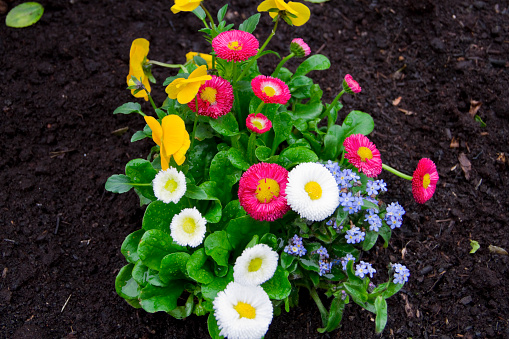Plant up a pot or hanging basket of winter-hardy herbs such as thyme, parsley and chives for the patio where it gets plenty of sun.

Picture: iStock
The dramatic drop in temperature earlier this week may be unwelcome, but it is true to the seasonal shift, with the first frost always expected towards the end of May.
For vegetable gardeners, noting the first and last frost date helps to plan future sowing.
Sean Freeman of Living Seeds advises that the last winter planting in the ground should be at least 3-4 weeks before the first frost. In areas that don’t get frost, the cut-off is when the night temperature drops below 10°C.
In spring, don’t sow in situ, or plant out young seedlings until after the last frost, usually towards the end of September.

Bellis perennis and violas add colour. Picture: iStock
Frost protection dos and don’ts
Do not cut off frost-damaged growth, even though it looks unsightly. It protects the rest of the plant from further frost damage.
Young plants, and salad greens, are frost tender and should be protected by frost cloth, especially if they are growing in a sunny but exposed area. Push some twigs or sticks into the bed and drape over the frost cloth so that it does not lie directly on the plants. Anchor the cloth on the ground, so that the heat cannot escape.
The purpose of the frost cloth is to retain the warmth generated by the soil during the day. Lay it over the bed late afternoon, while it is still warm, and only lift once the sun is warming the bed. Don’t leave the frost cloth on the veggies because they need the direct sun and good air circulation.
Frost damage occurs when the temperature drops to zero or below (usually early morning) which freezes the sap in the leaves, as well as the dew on the leaves. This causes the plant cells to rupture. Frost cloth should not touch the plants because that point of contact could freeze, especially if dew settles on the cloth.
If you don’t have frost cloth, protect tender plants by covering them with hay, dried leaves or pine needles. Open up around the plants when the cold spell is past. Lightly hosing down plants before the sun reaches them also helps mitigate the frost damage.

A frost cloth protects plants. Picture: iStock
Cold proofing the garden
Water as early as possible, so that the leaves are dry by nightfall. Watering can be reduced to once a week or once every two weeks to keep the soil moist. Damp soil holds the heat better than dry soil, protecting the plant roots.
A light bedding mulch insulates plant roots from the cold, but do not push the mulch up against the stems because they could rot.
Grow frost-tender plants in front of a north-facing wall that tends to get full sun in winter. At night it releases the heat, keeping the area warmer.
Trees, shrubs and fences can protect more tender plants from frost. Trees that lose their leaves in winter allow in the sun. This is a particularly good position for pansies and violas, that will last longer when the tree’s new leaves provide summer shade.
Fertilise winter flowering annuals and vegetables with a liquid fertiliser that is easily absorbed by the roots. Cabbage, cauliflower and other brassicas benefit from a nitrogen-based liquid fertiliser.

Pot of parsley. Picture: iStock
What to plant
Growth slows down, and winter is a season of dormancy and rest for most plants and gardeners. However, if pottering is your thing, here are three projects to keep you happy:
• Plant up a pot or hanging basket of winter-hardy herbs (thyme, parsley, chives) for the patio where it gets plenty of sun and is easily accessible for picking.
• Set up a potting table in a sunny, sheltered area and grow micro-greens or baby salad leaves in deep seed trays. Plant a new batch every two weeks for an ongoing supply.
• Fill up empty nooks and corners with pansies, violas, cineraria, Cape primrose (Primula acaulis) and bachelor’s buttons (Bellis perennis). Water once a week and feed every two weeks with a liquid fertiliser to boost flowering.
For more news your way, download The Citizen’s app for iOS and Android.
Download our app




